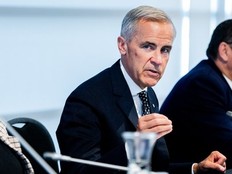GOLDSTEIN: Canada’s huge federal government bureaucracy needs to be downsized
During Justin Trudeau's Liberal government from 2015 to 2024, the federal bureaucracy grew in size by 43%

Article content
While the Canadian Centre for Policy Alternatives warned last week that over 57,000 federal public service jobs could be cut between now and 2028 due to Prime Minister Mark Carney’s restraint measures – assuming they occur – the reality is that a downsizing of the federal civil service is long overdue.
During Justin Trudeau’s Liberal government from 2015 to 2024, the federal bureaucracy grew in size by 43%, from 257,034 employees to 367,772, an increase of 110,738.
That far outstrips the 15% increase in Canada’s population between 2015 (35,606,734) and 2024 (41,012,563).
The 43% growth rate of the federal public service also outpaced the 18.5% real growth rate of the economy, the 15.5% growth in total employment and the 25.5% growth of employment across the entire public sector, counting all orders of government.
As Peter Nicholson, a former senior federal public servant and business executive who cited these figures in a policy paper last month for the Johnson-Shoyama Graduate School of Public Policy at the University of Saskatchewan observed:
“There is no reason to expect the growth of the civil service to match, much less exceed, population growth … By 2024, the number of federal public servants per 1,000 population had reached the highest ratio (9.0) in at least 40 years during which governments of various ideological stripes have held power.”
He noted this rapid growth occurred during an era when “so much specialized and urgent work is being outsourced to consultants.”
RECOMMENDED VIDEO
On that issue, parliamentary budget officer Yves Giroux reported in 2023 that despite the rapid increase in the size of the federal public service, the Trudeau government was also spending $21.4 billion annually hiring outside help – 106% more than the $10.4 billion spent when Trudeau took power in 2015.
Giroux reported the total cost of paying a full-time equivalent position in the federal public service – including salaries, pensions and benefits – increased by 7.7 % from $126,634 in 2022-23 to $136,345 in 2023-24, “exceeding the growth realized in any year since 2006-07.”
Meanwhile, “total personnel spending increased by 15.7% to $65.3 billion in 2023-24, from $56.5 billion in 2022-23.”
Some of these increases can be attributed to new federal programs such as dental care and pharmacare and increased hiring during the 2020 pandemic.
But that was five years ago and the size of the federal bureaucracy continued to increase every year after that up to 2024 – from 300,450 positions in 2020 to 319,601 in 2021; 335,957 in 2022; 357,247 in 2023 and 367,772 in 2024.
As of March 31, 2025, the public service was reduced by 9,807 positions to 357,965, compared to the same period in 2024, marking the first annual decrease in a decade.
Even with that 2.65% cut in the growth rate of the federal bureaucracy over one year, the overall 39% increase from 2015 to 2025 is well over twice the 16.6% growth rate of Canada’s population during the same period.
RECOMMENDED VIDEO
In a paper earlier this month, the Canadian Federation of Independent Business reported that from 2013 to 2023 (two years of the Stephen Harper Conservative government, eight years of the Trudeau government) the size of the federal bureaucracy increased by 36%, compared to just 13% job growth in the private sector.
“The rapid growth of the federal workforce and the accompanying surge in payroll expenditures risk crowding out private-sector activity,” authors Alchad Alegbeh and Christina Santini warned.
“This trend can reduce overall productivity, slow long-term economic growth, and limit the government’s ability to respond to future economic or fiscal shocks …
“The continued expansion of the federal public service – both in headcount and compensation – has become a growing source of concern for Canada’s small and medium-sized enterprises which represent the core of the private economy …
“While the federal public service has grown steadily, this has not been matched by improvements in economic performance or the business environment. In theory, a larger public sector could support business owners through streamlined regulations and efficient services. In practice, however, Canadian businesses face a costly and complex regulatory landscape – amounting to $51 billion annually.”
During the election, Carney promised to freeze rather than reduce the size of the public service, while increasing government productivity.
But governments of all stripes have promised increased productivity for years, without accomplishing it, meaning that new programs almost inevitably result in hiring more staff, instead of fewer workers doing the job more efficiently.
Critics say Carney’s recent instructions to most federal departments to cut program spending by 15% by the 2028-29 fiscal year will result in job losses and reduce the quality of government services.
But the reality, according to the numbers, is that downsizing the federal public service has become an economic necessity.













Postmedia is committed to maintaining a lively but civil forum for discussion. Please keep comments relevant and respectful. Comments may take up to an hour to appear on the site. You will receive an email if there is a reply to your comment, an update to a thread you follow or if a user you follow comments. Visit our Community Guidelines for more information.